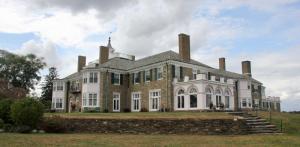Connecting international and local dots with Brip duPont
At 99 and making 100, Irenee duPont Jr. undoubtedly has more primary knowledge stored in his brain about one of America’s most historically influential families than any other person alive. The youngest of nine children and only son of a duPont mother and duPont father - second cousins - Brip - as he is known to friends and relatives - has been immersed in family history all of his life.
Following a three-and-a-half hour conversation at his and wife Barbie’s Granogue estate in northern New Castle County this week, his love for his sprawling family and its stories showed clearly what dominates his heart.
A mutual friend, Dave Marvin, introduced us and arranged the meeting. Dave has a home on Lewes Beach and in Wilmington where he lived while managing the DuPont Company’s pension fund for several decades.
When he left DuPont and started his own brokerage company with an associate, Dave became endowment manager for the fledgling Wilmington College - now Wilmington University. In that position he developed a close and lasting friendship with Brip, one of the university’s long-time trustees and former board chairman.
I grew aware of Irenee duPont Jr. many years ago while researching a legendary Dorchester County, Maryland boatbuilder - Bronza Parks. Before his untimely death in 1958, Parks built specialized oystering sloops known as skipjacks. Brip, in 1956, commissioned Parks to build him a modified skipjack as a sailing yacht for the Chesapeake Bay cruising he enjoyed. For years I’ve wanted to interview him about Parks and the Barbara Batchelder, named for Brip’s wife.
When Dave learned of my interest, he offered to arrange a meeting. I leapt at the opportunity.
As for what I learned about Bronza and the Barbara Batchelder from Brip, you’ll have to wait until I finish the book I’ve been working on for about 30 years. With any luck I’ll complete the task before I reach Brip’s age.
At one point in our conversation I addressed him as Mr. duPont. He stopped me quick, all the while his eyes laughing: “You can call me Ernie or you can call me Brip, but don’t you dare mister me.” My kind of guy, not a pretentious bone in his body.
I also knew we were kindred spirits when we were making sandwiches on the plastic-topped table in the upstairs conference room of his office. He had bought baloney and cheese, peanut butter and jelly, Farmhouse white bread, bananas, apples and TastyKake Krimpets for dessert. Cans of Ginger Ale and Mug Root Beer filled out the menu.
He didn’t want to use the serrated knife on the table for the peanut butter so he reached into the pocket of his khakis and pulled out a red Swiss Army Knife.
We were like two gunfighters. I reached into the watch pocket of my khakis and pulled out my own red Swiss Army knife. But he had outdrawn me.
I knew I was completely outclassed when he proceeded to use his knife to spread peanut butter and jelly on his baloney and cheese sandwich. That’s what I’m talking about. Fusion cuisine.
Connecting the dots
Brip connected all kinds of international, national, and Delaware dots as we conversed, Dave and I chiming in with our own dots here and there. It was just a good time.
He talked about his Uncle Pierre S. duPont’s momentous historical 1914 decision when, as president, he committed the company to accomplishing the near-impossible task of increasing its annual production of gunpowder tenfold in just a few months - from 10 million pounds to one hundred million pounds - to supply Great Britain and France in their existential fight against the invasion of Kaiser Wilhelm’s vastly better supplied German forces.
Brip was reverential in his regard for his uncle’s executive abilities. “He was a natural leader who made correct decisions with ease. Many company presidents in subsequent years spent hours in his office discussing company business.
The DuPont Company profited handsomely from being on the winning side in that war. Brip’s father, Irenee Sr., at brother Pierre’s insistence, took over the reins of the company after World War I. Realizing his own limitations, Irenee Sr., said Brip, transformed the company’s management to an executive board structure. That move harnessed the young and highly educated finance and chemical engineering entrepreneurial talent which in decades ahead invented and marketed such great successes as Nylon and Teflon, to name just a couple.
Pierre then turned his attention to Delaware, using the company’s profits to build the Port of Wilmington, and his own growing wealth to bankroll the construction of dozens of public schools to improve education for white and what were called colored students in that pre-integration era.
A few minutes later, Brip talked about his father’s involvement in the rehabilitation of Rehoboth’s Lake Gerar in the mid 1920s, when Brip was just a boy. “He bought a dragline scoop and had it reengineered with a Model T Ford engine to clean out what had been a swamp. With the reclaimed soil from the swamp, he built up lots around the new lake.”
The lots were eventually offered for sale by others involved in the initiative. Many were purchased by friends and relatives looking for an ocean resort experience. They agreed to build cottages on their lots within a certain time period to help Rehoboth grow and prosper.
Brip and Barbie eventually honeymooned in one of those cottages several years later.
“I borrowed my aunt’s Chevrolet, we drove to Rehoboth, and parked at the cottage. We never got in it again. We were able to walk everywhere and ate in several wonderful - and maybe some not so wonderful - eating places.”
Most duPont family members were driving General Motors cars at the time. DuPont’s owners, after the war ended, bought a 25-percent stake in the struggling auto company. With their finely honed management skills, the duPonters soon turned struggling GM into a profitable corporation. Too much success for some people’s taste. In an antitrust action in the late 1940s, the federal government forced duPont to divest itself of General Motors control.
Still loyal, these days Brip drives a 20-year-old Oldsmobile around his estate. In an attached garage he keeps the black Oldsmobile his father bought him when he was 16. And in another garage, he keeps the fully restored 1918 Cadillac that he bought from a salvage yard in Dartmouth, N.H., where he was a sophomore at the college.
“I was working on that Cadillac one autumn afternoon when I realized I didn’t like chemistry. That changed my life. I transferred to MIT and took up mechanical engineering which led to a career with the family business.”
From the elegant stone house built by his father and mother atop the grounds’ highest dome, where he and his sisters grew up, Brip and Barbie on a clear day can see as far north as Downingtown, Pa.
They’re now in their 75th year of marriage.
In the valley below, when winter chases the leaves, they can see the winding Brandywine River that powered the family’s earliest gunpowder mills in the late 1700s.
Across the great landscape of history he treasures so much, and reflecting on his near century of life, what does Brip duPont value as most important? “That I was born into the human race,” he says. “That I had a mother and a father for 60 years. For that I’m most thankful. Their love. That’s the most important thing,” he said. “Love.”























































